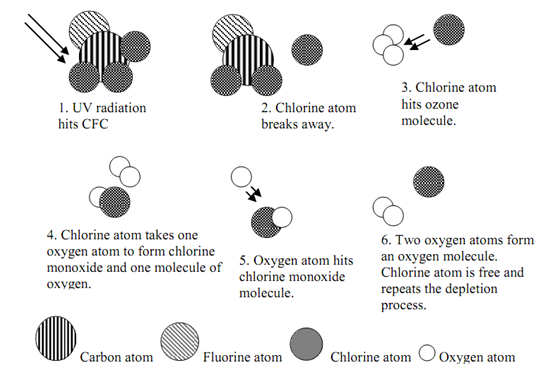Ozone Depletion and Global Warming Potential:
A subject of rising concern for the present day environment is the influence of the several refrigerants on the global warming and ozone depletion of the environment. The major culprits in this case are the chlorine having halogenated hydrocarbons, normally known as chlorofluorocarbons or CFC that are being utilized as refrigerants.
The Earth's atmosphere is built up of several layers. The layer only above the Earth's surface is called the troposphere. The tropospheres broaden up to 10 km from the surface. The ozone layer is only above the troposphere & located in the stratosphere. The stratospheric ozone is Earth's natural protection to destructive ultraviolet (UV) radiation from the sun. UV radiation is dangerous to human, plant & animal life. The ozone layer depleted by the activity of these refrigerants.
CFCs, while they are released from the surface of the Earth, go up slowly into the stratosphere. Here they are bombarded through the incoming UV light from the Sun that releases the chlorine atoms by the parent compound. This is this chlorine atom thta reacts with the ozone molecules. The detailed reactions are described below:

The free chlorine atom may again take part in the reaction along another ozone atom. A solitary chlorine atom, released by the activity of UV radiation on CFCs, may catalytically demolish tens of thousands of ozone molecules throughout its residence in the stratosphere .

Graphical Representation of the Reactions Involved in Ozone Depletion
Ozone depletion shall allow UV rays to attain earth that can result in various harmful effects on living creatures. The UV radiation may cause cataracts, skin cancer and obliteration of the body's immune system.
As well ozone depletion, CFC refrigerants also give contribution to a large extent in the global warming of the planet. These gases built a greenhouse effect that traps the heat in the lower atmosphere. It makes the Earth warmer due to the green house gases do not permit infrared radiation to pass through them. The earth emits IR rays throughout its cooling while sun is not there. CO2 is the most significant green house gas however one molecule of CFC has warming potential that is more than 1000 times the warming potential of one molecule of CO2. Sun's rays are permitted into the lower atmosphere; however the heat from these rays is not permitted to escape.
The "Montreal Protocol on Substances which deplete the Ozone Layer" signed in the year of 1987 by various countries stipulates the gradual phase-out of CFC refrigerants.
Utilization of HCFC refrigerant is advocated like an interim measure, however even these are to be ultimately phased out. Therefore this necessitates the requirement for new refrigerants that can at least carry out as well as the refrigerants they replace without damaging the atmosphere. Depend on this requirement, HFC 134a emerges as the refrigerant of the future.